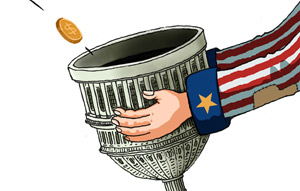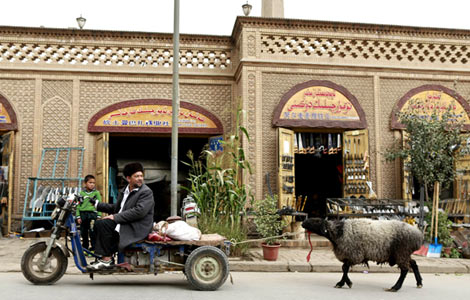Killer hornets wreak havoc
Updated: 2013-10-16 07:43
By He Na (China Daily)
|
||||||||
Small, but deadly
Li Tiesheng, an insect researcher at the Chinese Academy of Sciences' Institute of Zoology, who has visited Ankang on several occasions, said that in recent times, the hornets responsible for the most severe attacks were mainly Vespa Mocsaryana and Vespa Mandarinia, often called the Asian giant hornet. Their nests, the diameter of which can reach 40 or 50 centimeters, can house between several hundred to 10,000 hornets. They are often located high in trees and look like giant gourds. As a result, the locals often refer to the insects as "gourd hornets".
An adult hornet is roughly the size of a human adult's thumb. In addition to their impressive size, they are easily irritated, nervous, have a fierce character and are highly aggressive.
"Any people or animals touching the nest, whether on purpose or not, are vulnerable to group attacks. The yellow and black insects will use their stings, which are roughly 6 millimeters long, to inject a poison so powerful that it can dissolve human tissue," said Li Tiesheng.
While minor injury can cause breathlessness, a rapid heartbeat and violent trembling, serious attacks often result in death from renal failure or anaphylactic shock.
Li Tiesheng attributed the rising number of attacks to global warming in part. "The rise in temperatures has resulted in a greater number of hornets surviving the winter months, leading to a corresponding rise in overall numbers in recent years. Besides, this is the hornet's reproduction period. Like other creatures with high levels of aggression and vigilance in the reproduction period, they will carry out crazed attacks to protect their pupae," he said.
The attacks have mostly occurred in the southern part of Shannxi, mainly as a result of the rich diversity of plant species in the local Qinling Mountains and improvements in the local environment that provide sufficient food for the hornets' survival, he added.
Li Xin, a professor of insect research at Northwest Agricultural and Forestry University, concurred with Li Tiesheng's view that the wide range of plant species and environmental improvements have provided the hornets with a greater choice of sites to build their nests and proliferate.
"The market prices of some woodland produce such as fruit, medical herbs and hornets' nests are much higher than usual. The high profit margin drives more people to the mountains to pick fruit and collect herbs, but this activity disturbs the hornets. Generally they don't attack people. The safe distance to keep from a hornet is two meters, but once people enter their scope they will quickly attack because they feel threatened," he said.
He pointed out that although the hornets are color-blind, they have a keen sense of smell and are intrigued by moving targets. However, if one wears dark clothing, preferably brown, and does not move, the insects can't see you. "But a lot of people don't know that. They wear bright-colored clothing and run quickly when the hornets chase them. To the hornets, this is deliberately provocative behavior which prompts them to attack," he said.
Most Viewed
Editor's Picks

|

|

|

|

|

|
Today's Top News
A life devoted to China-US ties
US inches toward deal to reopen govt
Alcoa CEO to be feted by US-China Committee
Hong Kong and AmEx throw culinary extravaganza
'Against human nature'
Nation honors father of Xi Jinping
Information transparency vital for image
$100b trade target for 2017
US Weekly

|

|















